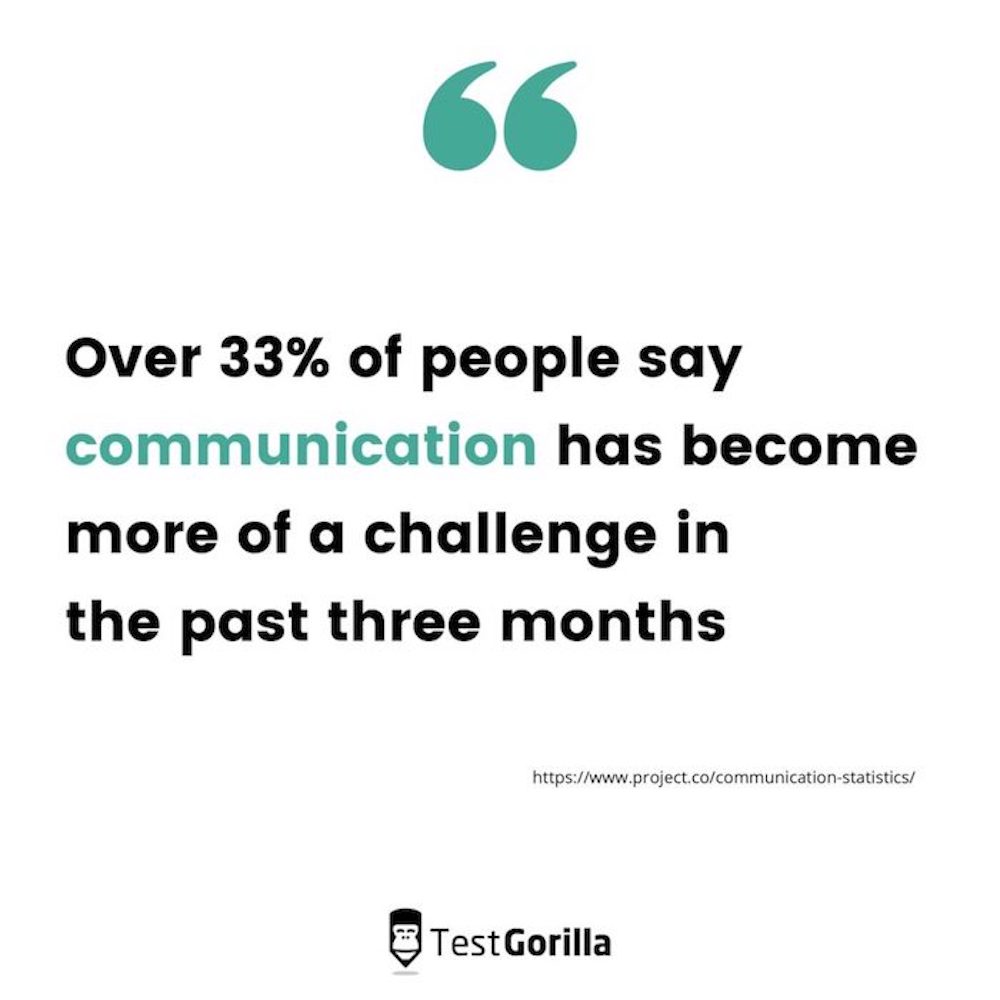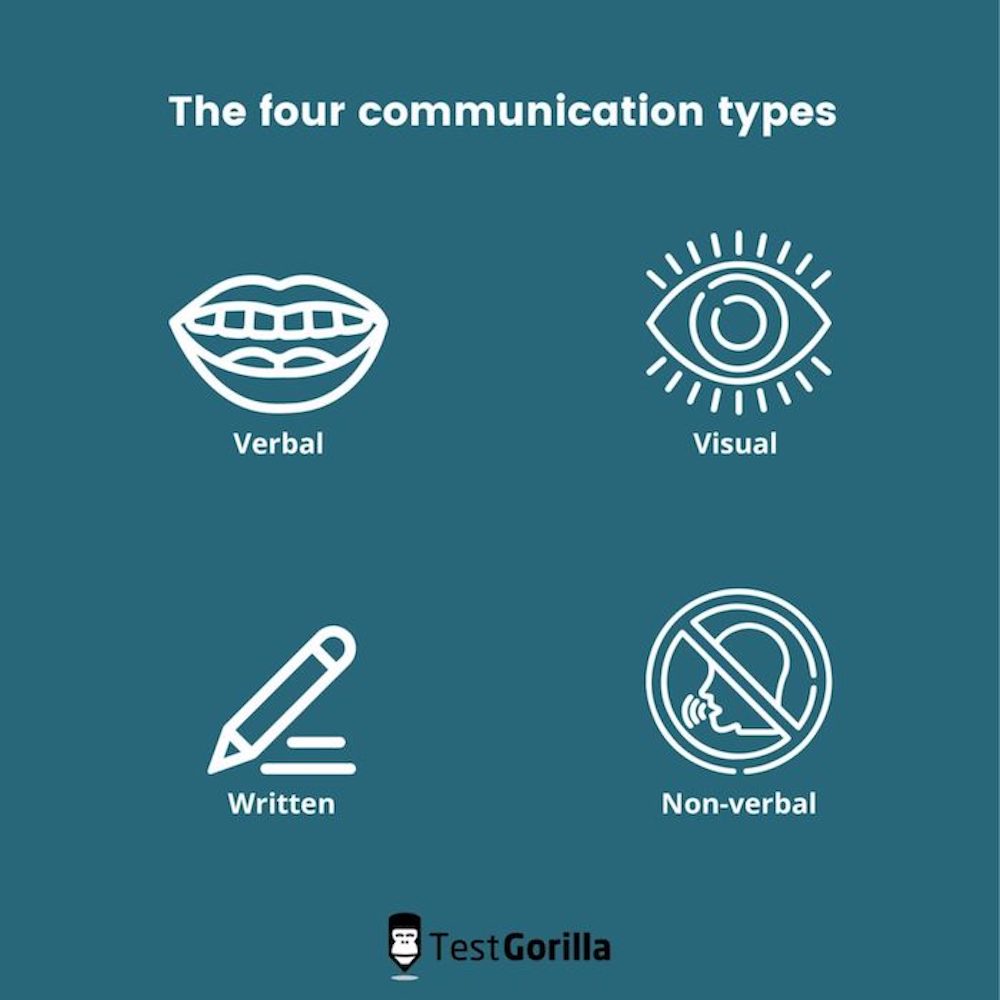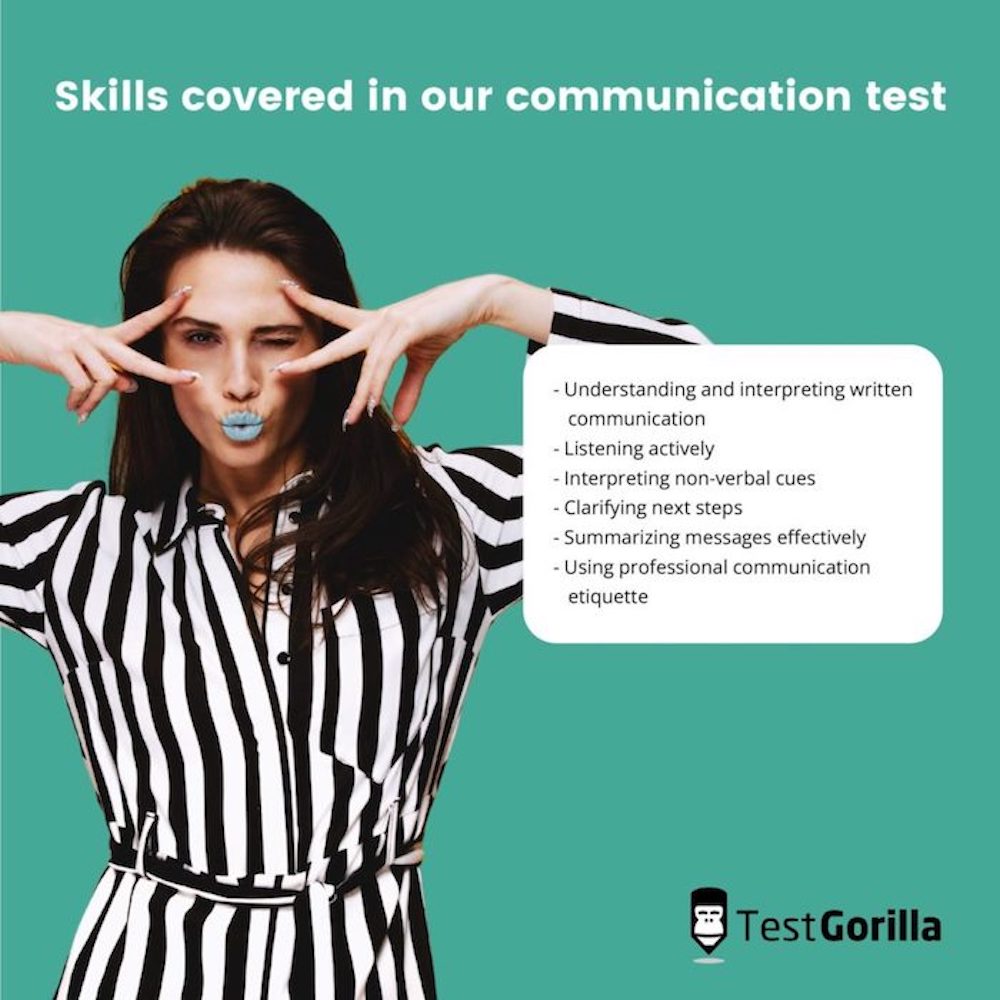Communication is an important soft skill to consider throughout the hiring process. It is at the heart of a successful team: sharing thoughts and information effectively is the best foundation to build a healthy and high-performing fortress on.
Table of contents
Let’s find out more about why communication matters so much, what the four communication types are, and how to test for them to hire the best.
Why is good communication important?
The short answer is that the better we communicate, the faster and better we get things done. If information, messages, and requests are delivered clearly with no need for clarification, there is less chance of misunderstanding. The pipeline from a project’s genesis to its realization becomes smooth and uncluttered.
Through effective and thoughtful interaction, problems are easily solved along the way, if not prevented altogether. Think of a baseball team. A good throw is an instance of good communication – bad throws are hard to catch, and just one bad throw can set the whole team back, no matter how skilled everyone is at catching the ball.
We should also consider that the shift to remote work has amplified the need for clear interaction. The rise in work-from-home means internal communication is increasingly taking place online. For many teams, communication has shifted entirely online.
This shift has put communication in the spotlight and allowed communication software companies to innovate and soften the transition. However, the truth is that digital communication has different problems and limitations that many of us still aren’t used to facing.
Though they’re great, emojis are not a substitute for body language and tone of voice, and we all know how easy it is to miss an email or a direct message. What’s more, 75% of HR leaders agree that remote work can put employees at risk of burnout via ‘virtual overload’. They agree any type of burnout is far from conducive to thoughtful communication.
In addition, there is evidence that employees are becoming increasingly impatient with these problems and limitations. Of 444 people surveyed in December 2021, over a third say communication has become more of a challenge in the preceding three months. Essentially, many of us have had to learn to throw and catch all over again.
What are the four communication types?
Despite the recent focus on digital forms of communication, all four communication types are important in both their online and offline iterations. So without further ado, here are the four communication types broken down for you.
1. Verbal
Verbal communication refers to a person’s ability to interact with others using spoken words both online and in person. We communicate verbally all the time in casual, personal, and professional settings. In the space of a day, your verbal interactions might range from ordering a coffee to interviewing for your dream job.
Whether expressed in person, over the phone, or on a video call, spoken words are the most personal form of communication. Therefore, they have the power to make or break an opportunity, and power comes responsibility. Subsequently, it is paramount to communicate well verbally to forge and maintain working relationships at all levels.
Trust builds with kind, clear, and appropriate verbal communication. When badly done, it can lead people to lose confidence in their leaders and teammates, or even in an organization as a whole.
Here are some tips for good verbal communication:
Be clear. Define your expectations and make sure they are achievable. Whoever you are communicating with must understand what you are saying and what it means for them. Avoid saying ‘um’, using stop words, or mumbling. It’s crucial to be open to questions, but being clear will keep them to a minimum.
Be confident and informed. Make sure you know what you are talking about and are well-informed enough to answer any questions. If you have confidence in what you are saying, it will be easier for others to have confidence in it, too.
Be empathetic. Speak kindly and patiently, don’t rush through things, and be open to receiving questions or feedback. Be respectful of whoever you are conversing with, especially when it is about a sensitive topic.
2. Non-verbal
Let’s introduce verbal communication’s subtle but powerful sibling.
Non-verbal communication is often overlooked because the effects can be subliminal or unintentional. However, it can be a great way to try and understand what other people are thinking. Sometimes actions do speak louder than words, and we are all capable of lying about how we’re feeling to varying degrees of deception.
The latter can be especially true at work because people often feel it is easier to smile and carry on than express discomfort and risk conflict. This type of communication can sneak over the thresholds of these intentions – think, for example, of all the smiles and scowls that you couldn’t quite contain.
Dr. Albert Mehrabian’s research from the 1970s is one of the most well-known modern investigations into non-verbal communication. His findings indicated that people guessed emotions conveyed in photos more accurately than through voice recordings at a ratio of 3:2.
The meaning of a message is communicated 7% through words, 38% through tone of voice, and 55% through body language.
Albert Mehrabian’s 7-38-55 Communication model
In a simpler interpretation, non-verbal interactions are understood on a spectrum between ‘open’ and ‘closed’ body language.
If someone’s body language is ‘open’ they might be relaxed in posture. This posture means the shoulders are resting back with no visible tension in their limbs. ‘Closed’ body language is visibly indicated by the opposite. Perhaps someone’s shoulders are hunched, or their arms and legs crossed.
Since these are things we are often unconscious of, being a good non-verbal communicator requires self-awareness. In his book The Skilled Helper, Chicago professor Gerard Eagan introduces the acronym SOLER as a basis for good non-verbal communication:
S: sit squarely
O: maintain an open posture
L: lean in slightly
E: make eye contact
R: relax
3. Written
As a communication type, written communication involves writing or typing things down to convey information to others. It is generally understood to be more effective than other communication types, especially when complex information is conveyed.
This is because it can be crafted to present things as simple as possible, and recipients can review and consult it as many times as they like – it provides a permanent record of the information. These are things that can’t be done with conversations or body language.
At work, the most common instances of this kind of interaction include emails and other messaging channels. These are largely used by everyone in a team or organization.
So, whilst written communication is not something we do every day just because we are human beings with mouths and bodies, it is still an important soft skill to pay attention to regardless of your job spec.
For some jobs, it will be at the center of the desired skillset. In these cases, testing for it will be a key step towards hiring the best candidate.
Content writers are one example: they are entrusted with crafting writing that conveys and captures the essence, persona, and tone of a brand. Personal assistants are another – if your job is to correspond on behalf of somebody else, it is important for them that your written communication is really up to scratch.
Because it is much harder to prescribe a ‘tone’ to written interactions, thinking about how your writing might be interpreted by others is key. We are, however, still grappling with a worrying cultural phenomenon: women tend to be more apologetic and friendly than men in their emails.
Men apologize less frequently than women because they have a higher threshold for what constitutes offensive behavior
Karina Schumann and Michael Ross, ‘Why women apologize more than men’ (2010)
Research shows that emails sent by women contain more ‘sorry’s, more exclamation marks, and more enthusiastic language. This is a sad index of a world where women still struggle to be taken seriously at work, and a cue for us all to be more aware of our unconscious biases when we encounter written communication.
To develop your written communication skills, you can use the following steps:
Keep it simple. Some things will be harder to keep simple than others, but this is an excellent rule of thumb. Your writing needs to be easy to read and easy to understand, especially if it contains any kind of instructions.
Read other people’s writing. Pay attention to what you like and find to be effective, and what you don’t like. Understanding how you respond to certain types of written communication is a good way to develop your style and best practice.
Revise and review your writing. Take the time to revisit it, and if you have doubts then consult a second pair of eyes.
With this last step, make sure the revision approach matches the nature of the task. You don’t need a proofreader for every email you send, whereas you’d want to check an important whitepaper over with others before its release. In these cases, make proofreading processes diverse: different experiences unlock different insights, and somebody with a very different lived experience from you will likely pick up on things you won’t.
4. Visual
Visual communication is the use of anything visual to relate information to a person or group – charts, infographics, drawings, videos, and photographs are a few examples.
Visual communication can be a useful tool for accommodating different learning styles that people have: it is often used to make information more accessible or digestible, especially when it is being communicated to people who have less knowledge about the content.
The emergence of social media channels as such powerful platforms for marketing means that smart visual communication strategies are key for businesses if they want to be competitive. Essentially, good visual communication will lead to higher and stronger engagement.
People remember 20% of information when reading text without visuals
Research from Bynder (2018)
Here are some tips for using visual communication effectively:
Simplify information. This can be done in a multitude of ways, not just with graphs and charts. Visual analogies, pictograms, and infographics are accessible and reduce text.
Think about your audience. Like with any kind of content or communication, it is important to tailor visuals based on who they are for. The information needs to be more accessible than it was before, and it’s important to be considerate of visual impairments.
Ask for feedback. Bad visual communication can make information appear more complex than it was in the first place. Asking others if they found visuals confusing or enlightening is the best way to gauge the success of visuals.
The best insights on HR and recruitment, delivered to your inbox.
Biweekly updates. No spam. Unsubscribe any time.
5 steps to hiring good communicators
Knowing about the different types of communication is one thing; hiring an effective communicator is another entirely. So, we’ve put together five easy steps to help you do exactly that.
Include a communication test as part of a complete pre-employment skills assessment based on the role you are hiring for. This way, candidates’ communication skills will be tested alongside other important factors – it wouldn’t do to hire someone on their communication skills alone.
Interpret the results in the context of the other tests and concerning the nature of the role you are hiring for.
Conduct an interview and pay attention to how the candidate listens and communicates throughout. Ask questions that will address weaknesses flagged in the test. For example: if a candidate doesn’t score well in active listening, you could explain something aks then ask them to clarify and summarise what you said.
With all of this in mind, hire the candidate who is the best fit.
Share the results with your candidates once the recruitment process is complete. Transparency is important, and it gives both successful and unsuccessful candidates a chance to learn about their soft skill strengths and weaknesses.
Making sure communication in the workplace is at its best is just as important as hiring candidates with impressive communication skills. With this in mind, check out our guide to improving workplace communication.
Hiring for communication skills
At TestGorilla, we have just the test to help you assess the communication skills of candidates.
Crafted by our subject matter expert, the test is designed to cover verbal, non-verbal, and written communication. It assesses the following skills:
Understanding and interpreting written communication
Active listening
Interpretation of non-verbal cues
Clarification of next steps
Effective summarization of messages
Use of professional communication etiquette
Sign up for a free plan today to start creating your own assessments. Hiring the best without bias or stress is easier than you think!
You've scrolled this far
Why not try TestGorilla for free, and see what happens when you put skills first.





















